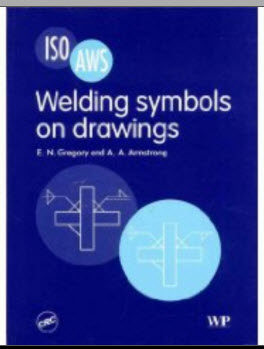Welding symbols on drawing book – E. N. Gregory and A. A. Armstrong

Cover book
Introduction
Symbols for indicating welded joints on engineering drawings were originally devised by individual drawing offices to provide more useful information than a simple arrow with the instruction ‘weld here’. This practice was obviously unsatisfactory, especially when drawings were passed from one company to another and, to solve this problem, the numerous symbols in existence were rationalized to some extent by countries compiling their own standard specifications for welding symbols.
The American system of symbolization is the AWS system, formulated by the American Welding Society (AWS). All AWS standards comply with the requirements of the American National Standards Institute (ANSI) and are designated ANSI/AWS. This system became widely used throughout the world, mainly because of the oil industry, and today is used by approximately half the world’s welding industry. The rest of the world uses the ISO system, designed by the International Organization for Standardization (ISO). However, a number of countries, particularly those with wide trading links, may use one system in their own country but need to use the other to satisfy the requirements of an overseas customer. Hence the need for a comparison of the two systems.
The British system was standardized in 1933 and the latest of five revisions, published in 1995 as BS EN 22553, is identical to ISO 2553.
For some years an ISO committee has been working on combining the ISO and AWS standards on welding symbols. It is expected that a combined standard will be published in the future which will standardize symbols on a worldwide basis.
It is important to appreciate the purpose of welding symbols, which is mainly to transmit information from the designer to one or more persons along the quality system network. This includes the welding engineer, welding supervisors, welders, inspection personnel and inspectors. In many cases it would be unfair to expect the designer to provide all the information possible from welding symbols without the help of a welding engineer and possibly from other welding and inspection personnel.
The minimum information provided by the designer should consist of the location and types of welds and the sizes and lengths of the fillet welds. The latter will require knowledge of the mechanical properties of the parent metal and the available filler metals. This will be simple for mild steel but more complex for low alloy steels, stainless steels and non-ferrous alloys. A lot of supplementary information can be added to a welding symbol but it may be more convenient and, indeed, useful to include this in a written Welding Procedure Specification (WPS). This procedure is recommended in the ANSI/AWS standard.
It is permissible, therefore, to use a standard on welding symbols for guidance, provided that the drawing indicates at least the locations and sizes of welds, any additional information being provided on a WPS or by detailed notes drawings.
Content
Introduction
Scope
Standards referred to in this book
Terms and definitions
- The need to specify welds
- The advantages of symbols
- Welding symbols 1
- Welding symbols 2
- Welding symbols 3
- Location of symbols 1
- Location of symbols 2
- Supplementary symbols
- Dimensions 1
- Dimensions 2
- Dimensions 3
- Spot and seam welds
- Stud welds
- Surfacing
- Process identification
- Non-destructive testing symbols – AWS
- Exercises
Download book – Welding symbols on drawings